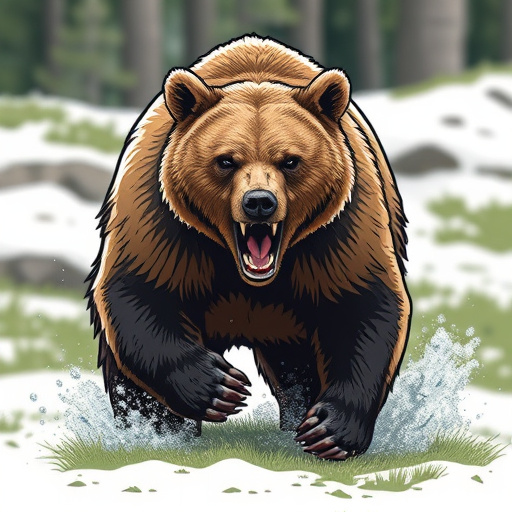Bear spray, using capsaicin to irritate bears' eyes and respiratory systems, is effective up to 20-35 feet (6-10 meters). Optimal shooting distance depends on wind conditions, terrain, and elevation. Choose bear spray with a suitable effective range, comfortable size, and good reputation. Proper use involves vigorous shaking, aiming at the bear's face within 20-40 feet (6-12 meters), spraying for 3 seconds, and backing away slowly. Local regulations regarding bear spray, including its effective distance, should be followed.
“Staying safe in bear country is a vital consideration for outdoor enthusiasts. One effective tool in your defense against black bears is bear spray. This comprehensive guide explores the essentials of bear spray, delving into its basics, shooting distance factors, and choice of spray types.
Learn about application techniques, safety tips, legal considerations, and best practices to ensure you’re prepared when encountering a bear. Optimize your protection by understanding the ideal effective shooting distance range for maximum effectiveness.”
- Understanding Bear Spray Basics
- Factors Influencing Effective Shooting Distance
- Choosing the Right Bear Spray for You
- Application Techniques and Safety Tips
- Legal Considerations and Best Practices
Understanding Bear Spray Basics
Bear spray, also known as bear repellent, is a powerful tool for self-defense against aggressive black bears. It’s designed to deter bears by irritating their eyes and respiratory system when sprayed directly at them. Understanding how bear spray works and its effective shooting distance range is crucial for anyone venturing into bear country.
The key to bear spray’s effectiveness lies in its active ingredient, capsaicin, which is derived from chili peppers. When sprayed, the aerosol reaches a targeted area, causing temporary blindness and severe coughing, making it difficult for the bear to focus and attack. The ideal shooting distance range for bear spray is between 20 to 35 feet (6 to 10 meters), allowing users enough time to deploy the spray while maintaining a safe distance from the bear.
Factors Influencing Effective Shooting Distance
Several factors determine the effective shooting distance for bear spray, which can significantly impact its overall effectiveness in deterring an attack. One crucial factor is the wind condition. A headwind can carry the spray back towards the user, while a tailwind might blow it away from the bear, reducing its concentration at the target.
The terrain and elevation changes also play a role. Shooting downhill or on sloping ground increases the risk of the spray dispersing before reaching the bear due to gravity. Conversely, elevated areas can cause the spray to settle faster, increasing its potential impact distance. Understanding these factors helps users optimize their positioning and aim for maximum effectiveness when using bear spray in various environments.
Choosing the Right Bear Spray for You
When selecting bear spray, understanding your needs and the product specifications is key. The first consideration is the effective shooting distance range – how close a bear can be before the spray kicks in. This varies between brands and types, so check the manufacturer’s guidelines. Typically, you want a product that allows for a safe distance to repel an attack.
Additionally, consider factors like bearing capacity (how much weight the can hold) and can size, ensuring it fits comfortably in your hand or on your body. Look for bear spray with a good reputation for consistent performance and a wide range to give you peace of mind while hiking or camping in bear country.
Application Techniques and Safety Tips
Effective use of bear spray requires proper application techniques. First, ensure the can is shaken well before each use to distribute the chemicals evenly. When faced with a bear, remain calm and back away slowly while aiming the spray towards the bear’s face and eyes. The ideal shooting distance range for bear spray is 20-30 feet (6-9 meters), but it can be effective up to 40 feet (12 meters) in ideal conditions.
Always keep your bearing on the bear, spraying continuously for about 3 seconds to create a barrier of foam that obscures its vision and causes irritation. Keep in mind that wind direction plays a crucial role; spray away from yourself to avoid inhalation of the chemicals. Safety tips include storing bear spray out of children’s reach and keeping it readily accessible during outdoor activities in bear country. Regularly check expiration dates, as bear spray can lose effectiveness over time.
Legal Considerations and Best Practices
When considering defense against black bears, understanding legal considerations and best practices is paramount. In many areas where black bear encounters are common, there are specific regulations regarding the use of bear spray. It’s crucial to familiarize yourself with local laws before carrying or using any type of bear deterrent. The effective shooting distance range for bear spray varies based on factors like can size, aerosol pressure, and environmental conditions. Typically, a good quality bear spray can be effective up to 30 feet (9 meters), but this can reduce in windier or colder environments.
Best practices dictate that you only use bear spray as a last resort when all other avoidance tactics have failed. Aim for the bear’s face and eyes to maximize its effectiveness. It’s important to stay calm, back away slowly before deploying the spray, and then move away from the area once sprayed to allow the bear time to leave. Regularly updating your knowledge on bear behavior and safety protocols is essential in ensuring your safety during outdoor activities in bear country.
Bear spray is a valuable tool for personal safety in bear country, but understanding its effective shooting distance range is crucial. By factoring in elements like bearing, wind, and terrain, you can maximize its impact. Choosing the right bear spray and mastering application techniques will ensure its reliability when facing an encounter. Always stay informed about legal considerations and follow best practices to create a safe environment for both yourself and bears. Remember, knowledge and preparation are key to navigating these encounters with confidence.
